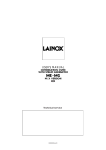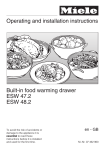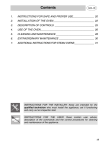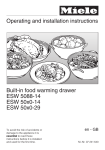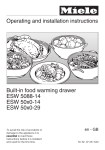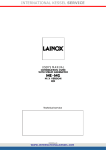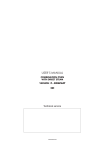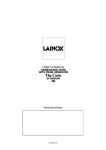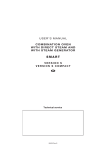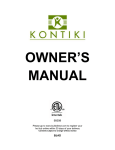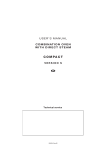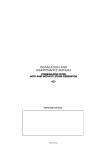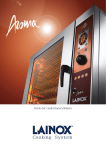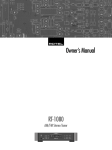Download User`s Manual D-H
Transcript
USER'S MANUAL DIRECT STEAM COMBINATION OVEN D/H VERSION EN Technical service 00000000rev00 16 • DETTAGLI CONTENTS OPERATIVI 1 • 2 • 3 • 4 • 5 • 6 • 7 • 8 • 9 • 10 • 11 • 12 • 13 • 14 • 15 • 16 • PAGE. 3 4 5 6 7 8 9 11 12 13 16 18 19 20 20 20 GENERAL REMINDERS POINTS TO REMEMBER DESCRIPTION OF KEYS STARTING ONE PHASE MANUAL COOKING STARTING MANUAL COOKING WITH TWO OR MORE PHASES IN SEQUENCE SETTING THE CORE PROBE (VERSION H ONLY) CORE PROBE + ∆T SYSTEM (VERSION H ONLY) HINTS ON USING THE CORE PROBE (VERSION H ONLY) AUTOMATIC HUMIDITY CONTROL SYSTEM (VERSION H ONLY) REHEAT PROGRAM (VERSION H ONLY) OPERATING DETAILS PRACTICAL ADVICE DAILY CLEANING ROUTINE MAINTENANCE MAJOR SERVICING SELF-DIAGNOSIS AND FAULT IDENTIFICATION ELECTRIC MODELS VE 106 VE S24 VE 110 VE S20 GAS MODELS VG 106 VG S24 VE C24 VG 110 VG C24 VE S40 VG S20 VG S40 VE C20 VE C40 VG C20 VG C40 VE 210 VE 227(1) VG 210 VG 227(1) VE 211 VG 211 (1) All versions of model V. 227 . have two independent ovens. VERSIONS D Electronic with cooking sequences and humidifier. H Electronic with cooking sequences, automatic humidity control, twin speed, core probe and lighting. The manufacturer accepts no liability for any inaccuracies in this manual attributable to printing or copying errors. We reserve the right to modify our products as we deem fit, without impairing their basic features. The reproduction or copying of any part of this manual by any means whatsoever is strictly forbidden unless authorized previously in writing by the manufacturer. donadini & c. advertising © - 016.38.122 - 16.02.2000 2 00000000rev00 1 • GENERAL REMINDERS Repairs may become necessary over time; these and all major servicing operations must be entrusted exclusively to a Lainox technician or a Lainox authorized service agent. 1.1 1.2 1.3 3N TYP. VE 106 "X" 2000 NR xxxxxxxxxx AC 400 V 50 Hz 8 • Carefully read the directions given in this manual; they contain important information on safety during installation, operation and maintenance. Keep the manual in a safe place for future consultation! IPX 5 • This appliance must be put only to the use for which it is specifically intended, i.e. cooking foods. Any other type of use is improper and therefore dangerous. - 98 LX TYP. VG 110 "P" 2000 AC 230 V kPa 150 - 500 kW TYP. NR xxxxxxxxxx 1.00 kW kPa 50 - 500 • Only trained kitchen staff should be allowed to use the appliance. A1 1.4 • The oven must not be left unattended during operation. IT 1.5 • There are surfaces of the oven that become hot during operation. Take care! IPX 5 1.6 • Ask the installer for information on correct operation and use of the water softener; incorrect or incomplete regeneration of the resins will result in inadequately treated water, which could damage the oven. 1.7 • Should it become necessary to call out a service technician, all essential identification details of the appliance are shown on the data plate. B21 P mbar 20; 28-30/37 8; 20 0085 1.8 • In the event of technical assistance being required, the trouble must be described in as much detail as possible, so that a service technician will be able straight away to understand the nature of the problem. 1.9 • The room in which the oven is to operate must be well ventilated! 1.10 • In the event of breakdown or faulty operation, switch off the oven immediately! 3 00000000rev00 2 • POINTS TO REMEMBER 2.1 • Before any food is cooked in a new oven, the interior must be thoroughly cleaned (see the “Daily Cleaning” heading). 2.2 • At the end of the working day, clean the oven thoroughly inside and out; this will ensure smooth operation of the appliance and prolong its useful life. 2.3 • Do not use high pressure water jets when cleaning the oven! 2.4 • For daily cleaning, use non-corrosive products (alkali based) suitable for the purpose. Abrasive materials and products should not be used as they will damage the surfaces. 2.5 • Always switch off the appliance when work is finished, and shut off all energy supplies (electricity, water, and gas if connected). 2.6 • Avoid any operation that might cause cooking salt to be deposited on the steel surfaces of the oven; if salt is accidentally spilled, rinse off immediately and thoroughly. 2.7 • After steam cooking, open the door carefully to avoid being hit by the rush of residual steam escaping from the oven. Failure to observe this warning may be dangerous for the operator. 2.8 • To ensure safe operation of the oven do not obstruct the vents or any other opening in the casing! 2.9 • To ensure long term efficiency and reliability of the oven, major servicing should be carried out at least once a year. With this in mind, customers are recommended to sign a service agreement. Failure to observe basic safety guidelines may jeopardize the smooth operation of the oven and expose the operator to serious danger! The manufacturer accepts no liability if the original function of the oven is altered or there is tampering or failure to observe the instructions given in the manuals. 4 00000000rev00 3 • DESCRIPTION OF KEYS FOREWORD This page describes the control indicators (which signal any fault occurring during operation), the service keys (which, at any moment, activate the additional services available, provided that the oven is working and the LED of key 28 is permanently alight), the additional functions (which activate special cooking methods, described in detail on the following pages) pertaining to the model and version shown on the previous page. 3.1 • CONTROL INDICATORS 4 No water indicator light. 1 Fault display. 3.2 • IMMEDIATE RESPONSE FUNCTIONS Rapid cooling key with oven hot and door open. Open the door and press key 30: ventilation is activated to lower the oven temperature rapidly down to 50°C. This function can be used after a cooking operation that is to be followed by another one using a much lower temperature. Vent open Vent closed FOR VERSION H ONLY Note: The position of the vent can be saved. For example: phase 1 = vent closed; phase 2 = vent open. Oven light key. Pressing this key, the oven light will come on for a timed duration (standard duration 20 seconds. Call your technical service centre if you wish to change this setting). Note: The appliance is fitted with an automatic system for lowering the temperature that operates in all cooking modes. If the temperature exceeds the display setting by 30°C the humidifier automatically directs cold water into the oven and the temperature is rapidly lowered This precludes the possibility that food could start cooking with too high a temperature in the oven. In addition, the added moisture prevents dishes from drying up. Temporary manual oven moisture inlet key. Keep key 38 pressed for as long as you like: water is sprayed into the oven, increasing its humidity level. This function is activated only in convection and combination modes, and is useful for foods that require added humidity when cooking. 3.3 Open oven vent key. This function can only be activated in convection mode. Pressing key 27 opens the oven vent (LED permanently alight for version H only), turning the butterfly valve 39 for version D, evacuating the excess moisture in the oven 5 00000000rev00 • ADDITIONAL FUNCTIONS Reheat program selection key 37. FOR VERSION H ONLY Normal/low fan speed selection key. The normal speed is usually activated (left LED permanently alight); pressing key 11 activates the low speed (right LED permanently alight). The low speed is particularly useful when cooking delicate foods. This function automatically activates energy saving. Temperature control key 24 with ∆t combined with the core probe. 4 • STARTING ONE-PHASE MANUAL COOKING OPERATIONS 4.1 • SWITCH ON Press key 5 to switch on. 4.6 4.2 • SELECT Select the cooking mode: convection 10, steam 13, combination 12. 4.3 • SET Set the cooking temperature with knob 18. 4.4 • SET Set the cooking time with knob 21. Or you can set the cooking temperature regulated by the core probe in the product by using the keys 23. 4.5 • START Start the oven by pressing key 28 (LED permanently on). 6 00000000rev00 • END OF COOKING If infinite time [ inf ] has been selected, switch off the oven manually using key 28 (LED alongside key OFF). If a cooking time or core probe temperature has been entered, a beep of approx 5 seconds duration will be generated at one minute intervals when the time expires or the temperature has been reached, to indicate that cooking has terminated and the oven has switched itself off (LED next to key 28 off). Just open the door to stop the beeping. Remove the food from the oven, following the directions given under paragraph 2.7 of the “Points to remember” heading. 5 • STARTING MANUAL COOKING WITH TWO OR MORE PHASES IN SEQUENCE OPERATIONS 5.1 • SWITCH ON Press key 5 to switch on. 5.2 5.3 5.7 • SELECT Press key 3 to select the cooking phase [ 3 ]. Set the cooking mode, temperature and time as described in previous headings. • SELECT Select key 3 to select the cooking phase [1 ]. 5.8 • START Start the oven by pressing key 28 (LED permanently on). • SELECT Select the cooking mode: convection 10, steam 13, combination 12. 5.9 • END OF COOKING If infinite time [ inf ] has been selected, switch off the oven manually using key 28 (LED alongside key OFF). If a cooking time or core probe temperature has been entered, a beep of approx 5 seconds duration will be generated at one minute intervals when the time expires or the temperature has been reached, to indicate that cooking has terminated and the oven has switched itself off (LED next to key 28 off). Just open the door to stop the beeping. Remove the food from the oven, following the directions given under paragraph 2.7 of the “Points to remember” heading. 5.4 • SET Set the cooking temperature with knob 18. 5.5 • SET Set the cooking time with knob 21. OR you can set the cooking temperature regulated by the core probe in the product by using the keys 23. 5.6 • SELECT Press key 3 to select the cooking phase [ 2 ]. Set the cooking mode, temperature and time as described in previous headings. 7 00000000rev00 6 • SETTING THE CORE PROBE FOREWORD The core probe allows cooking to be regulated by monitoring the temperature at the core of the product. This device overrides the time setting, and cooking stops as soon as the temperature at the core of the product reaches the selected value. OPERATIONS 6.1 • COOKING WITH THE CORE PROBE Once the oven temperature has been set (as described in the relative headings), press the keys 23 to enter the desired core temperature. Insert the probe into the food (see “Hints on using the core probe” ), plug the lead into the panel socket (36) and proceed according to the cooking mode selected. Therefore, if you have chosen... 6.1a • 6.1b • MANUAL COOKING, MANUAL COOKING WITH ONE PHASE: TWO OR MORE PHASES press key 28 to start cooking. IN SEQUENCE: If, when setting the core probe, knob 21 is turned to the left to select infinite time and cooking then started, the food can be held at the set temperature when cooking is completed. The dish will keep warm until such time as the cycle in progress is interrupted (e.g.: by opening the oven door). PRACTICAL EXAMPLE Setting Mode: Convection (10) Oven temperature: 140 °C (18) Time: Infinite (21) Core temperature: 78°C (23) What happens Once the temperature at the core of the food reaches 78 °C, with the oven temperature at 140 °C, the heat source shuts off and will automatically come into operation again when the core temperature drops by 1 °C. In practice, it is no longer the oven temperature setting that regulates the operation of the heat source, but the temperature selected for the core probe. pass on to setting the next phase or press key 28 to start the first phase of the selected cooking mode. Note: When cooking in manual mode using two or more phases, the electronics do not permit entering a cooking phase with the core probe after any cooking phase with infinite time. 8 00000000rev00 6 • SETTING THE CORE PROBE Advice Once cooked, food can of course only be kept warm for a limited period of time, which must not exceed current health and hygiene regulations. The holding temperature is precise to within 1 °C. Ideal for large items of food. Note: Using this system of cooking and holding with the convection mode, it is possible to combine automatic humidity control, which creates the ideal humidity avoiding drying up the product. Advantages Food can be kept as if “freshly cooked” for as long as you like, without the operator doing anything, consuming extremely little power. The succulence of the food remains undiminished. 7 • CORE PROBE + ∆T SYSTEM With the ∆t system, food need not be assailed by high temperatures, but instead can be uniformly cooked and remain tender, while shrinkage is also considerably reduced. FOREWORD The ∆t function allows the core probe to be used while maintaining a constant difference between the temperature at the core and the temperature in the oven. OPERATIONS 7.1 • COOKING WITH THE ∆T SYSTEM Once the oven temperature and the core probe temperature have been set (as described in the relative headings), press key 24; Insert the probe into the food, as described in “Hints on using the core probe”, plug the lead into the panel socket 36 and proceed according to the cooking mode selected. Therefore, if you have chosen ... 7.1a • 7.1b • MANUAL COOKING, MANUAL COOKING, ONE PHASE: TWO OR MORE PHASES: press key 28 to start cooking. pass on to setting the next phase or press key 28 to start the first phase of the selected cooking mode. 9 00000000rev00 7 • CORE PROBE + ∆T SYSTEM OPERATIONS PRACTICAL EXAMPLE Setting Mode: Combination (12) Oven temperature: 120 °C (18) Core temperature: 68 °C (23) Ideal for: large items, fresh and delicate or unseasoned meats, fibrous meats, game. Advantages During cooking, the heat penetrates the food gradually and uniformly, rendering it succulent, soft and tender and avoiding any hint of burning on the surface. Shrinkage is much less than with any other cooking mode, so that the specific yield of the product is greater. Cooking can be carried out during dead time, and operating costs thus reduced. Flavour and firmness are maintained at optimum levels. What happens From the settings, the electronics determine the ∆t, which does not have a fixed value, but is a function of the data entered (for example: 120 °C - 68 °C = ∆t 52). When started, the oven rapidly heats to the ∆t value + the temperature already existing at the core of the food. The oven will then be regulated in such a way that the difference between the two temperatures remains constant, i.e. equal to the determined ∆t value. Advice This type of cooking takes longer; the lower the ∆t the longer the time, but the greater the yield. The values to enter for the oven temperature should not exceed 130/140 °C. If the product requires browning, a final convection phase at a higher temperature is required. Temperature °C oven temperature 120 temperature at core of product 68 ∆t 20 Cooking time 10 00000000rev00 8 • HINTS ON USING THE CORE PROBE Optional: On request and without any specific adaptation, it is possible to connect the needle probe to the front panel to control the temperature of vacuum-packed foods. In cooking with this device, the position of the core probe is extremely important. The probe must be positioned from the top downwards at the centre of gravity of the food to cook and be fully inserted. In pieces whose thickness is less than twice the probe, which is inserted horizontally to the tabletop so that the tip of the probe is anyhow in the middle of the food (see figure). It is also recommended that the probe be inserted with the food positioned at the centre of the oven. NO YES NO YES Advantages • Improves control over the cooking process, eliminating the risk of loss and waste; • Permits accurate cooking irrespective of the quality or mass of the product; • Saves time because cooking control is automatic; • Guarantees hygiene; with precision monitoring of the core temperature, there is no need for food to be handled, poked or prodded. Cooking with the core probe is ideal for: • large items that require cooking in a particular way at the core (roast-beef, salmon, etc.); • cooking vacuum-packed products (using the needle probe, optional). 11 00000000rev00 9 • AUTOMATIC HUMIDITY CONTROL SYSTEM FOREWORD The automatic humidity control system makes it possible to keep a constant level of humidity in the oven when cooking by convection. It performs a twofold function, it does not work by only introducing moisture, but also (version H only) by extracting the moisture of the product when it exceeds the set value. Especially advantageous for fresh products that cannot have the same moisture content from one day to another, but which when cooked will always have the same aspect and firmness. This system is recommended in particular for cooking different quantities of the same type of food, in order to maintain a balanced cooking atmosphere: with the oven half full, the level of humidity is increased by the system, whereas with the oven full, the vent opens automatically to release excess moisture. OPERATIONS Note: The vent must be closed, because if it were set open it would automatically cancel the setting of the automatic humidity control (version H only). 9.1 • COOKING WITH THE AUTOMATIC HUMIDITY CONTROL SYSTEM Note: The cooking mode must be convection! Once the oven temperature or the core probe temperature have been set (as described in the relative headings), press key 38. The display shows [ HO ] and, within approximately 2 sec., enter the required automatic humidity control value, from 1 (very dry) to 99 (99% relative humidity). Put the food in the oven and, if the probe is set, insert the probe in the food (see under the “ Hints for using the core probe ” heading), plug the probe into the panel (36) and then proceed with the chosen method of cooking. Therefore, if you have chosen ... 9.1a • 9.1b • MANUAL COOKING, MANUAL COOKING, ONE PHASE: TWO OR MORE PHASES: press key 28 to start cooking. pass on to setting the next phase or press key 28 to start the first phase of the selected cooking mode. Advice Definition of the automatic humidity control value requires a certain amount of practical experience. Nonetheless, it is impossible to commit a catastrophic error, and this function undoubtedly enhances the appearance of the food. Ideal for: Foods that tend to dry up, or small items or foods that release excess humidity and when reheating especially on a plate. Advantages Repeatable results, even when foods are cooked together with others having different characteristics. 12 00000000rev00 10 • REHEAT PROGRAM Foods can be reheated either in a pan or on a plate. The memory holds up to 5 programs, of which the first two are preset by the manufacturer. FOREWORD The reheat program is part of an organized kitchen management system: cooking ➡ cooling ➡ conserving ➡ reheating ➡ service. OPERATIONS 10.1 • SWITCH ON THE OVEN Press key 5. A short beep indicates that the self-diagnosis routine has been completed. If a symbol appears in the fault warning display, refer to the “Selfdiagnosis and fault identification” heading. 10.3 • PROGRAMS ALREADY INSTALLED R1 AND R2 Values already set for program R1 Mode: Convection (10) Fan speed: Normal (11) Oven temperature: 130 °C (18) Time: Infinite (21) Humidity: 20% (38) 10.2 • SELECT THE REHEAT PROGRAM Note: Programs R1 and R2 are already stored in memory. Press key 37, the left LED remains permanently alight. This indicates the R1 reheat program has been selected. To select the R2 program, press the key a second time, the right LED remains permanently alight. Values already set for program R2 Mode: Combination (12) Fan speed: Normal (11) Oven temperature: 130 °C (18) Time: Infinite (21) Humidity: 40% (38) Note: With the reheat program it is possible to use the combination mode setting with automatic humidity control or with the vent open. This is particularly suited for reheating food on a plate to prevent condensation forming on the plate. 13 00000000rev00 10 • REHEAT PROGRAM OPERATIONS 10.4 • MODIFICATION OF PROGRAMS R1 AND R2 Press key 3 to access the setting. Carry out the single programming operations in succession within approximately 5 sec., otherwise, to access programming again, press key3 again. The display 3 shows no.1 flashing (phase 1). Select the preheat mode, if different to the one prompted. Change the fan speed, if necessary (version H only), remembering that this will reduce the heat output of the oven in operation. Enter the oven temperature. Set the time, which generally will be infinite, by turning the relative knob, or enter the core probe temperature (version H only), it is advisable to use the needle probe for particularly thin or small items, using keys 23, if the size and consistency of the food permit. At this point we recommend entering the automatic humidity control function, see under the relevant heading or open the vent. Wait for a few seconds for the data to be saved, when a sequence of 5 beeps indicates that the save has taken place. What happens Start the program after introducing the food in a pan or on a plate. As the two preset programs are not regulated by the core probe, additional care needs to be taken in the programming of reheat times until a certain familiarity with the system has been acquired. Advice Reheating is intended as a process of warming previously cooked foods to a nominal serving temperature of 65 °C at the core. This must take place as quickly as possible, clearly observing the local health and hygiene regulations. For deep-frozen and/or frozen products, the oven temperature is set to 160 °C and the food exposed to the heat for a few minutes until defrozen sufficiently to allow insertion of the core probe; obviously, the program needs to be temporarily modified. Advantages This system makes it possible to present the food “freshly cooked” as regards its appearance, flavour and firmness, even after a few days’ conservation at +3 °C. The appliance is versatile as it can perform differentiated functions without the aid of additional equipment. 14 00000000rev00 10 • REHEAT PROGRAM STARTING THE REHEAT PROGRAM OPERATIONS Place the food to reheat in the oven, following the directions given under the “Practical Advice” heading. Insert the core probe (see “Hints on using the core probe”). 10.6• END OF COOKING To stop the reheat program, just open the door. Remove the food from the oven, following the directions given under paragraph 2.7 of the “Points to remember” heading. 10.5• START Press key 28: the LED associated with the key stays on permanently. Displaying entered values If, during reheating, it is necessary to check the set values, press key 37. At this point ... the temperature display indicates the actual oven temperature. The time display: • indicates [ inf ], if infinite time has been set; • counts the operating time, if the core probe is active; • indicates the remaining time, if a time has been set. 15 00000000rev00 11 • OPERATING DETAILS FOREWORD During cooking (LED permanently on), the displays show the actual values. It is anyhow possible to check the set values. In this connection, proceed as follows: OPERATIONS 11.1 • DISPLAYING SET VALUES DURING COOKING (without stopping) Press the key of the cooking mode previously selected (corresponding LED on steady). You hear a beep and the display shows the values set beforehand. After 5 sec. the real values reappear. 11.4 • CHANGING THE TEMPERATURE SET FOR THE CORE PROBE Keep one of the keys 23 pressed to enter the new value; then you hear a beep and the display shows the value you have just set. After 5 sec. the real values reappear. 11.2 • CHANGING SET VALUES DURING COOKING (WITHOUT STOPPING) 11.2 a • TEMPERATURE AND TIME To change the value, press first the cooking mode and then turn the relevant knob to enter the new value (to the right, increase to the left, decrease); you then hear a beep, the displays show the values you have just set, after 5 sec. the actual values reappear. 11.2 b • COOKING MODE Press the key associated with the new cooking method, the associated LED will light up; then you hear a beep and the display shows the value you have just set, after 5 sec. the actual values reappear. Version H only 11.3 • CHANGING THE FAN SPEED Press the fan speed key 11. The LED corresponding to the new speed setting will light up (left-hand LED = normal speed; right LED = low speed; after 5 seconds a beep indicates that the speed has been changed. 16 00000000rev00 11.2 c • AUTOMATIC HUMIDITY CONTROL Press the key for the selected cooking mode (corresponding LED permanently on, you then hear a beep) and then press the automatic humidity control function key (the display shows [ H.. ], the value entered previously). Turn the knob to set the new value. After 5 sec. the real values reappear. 11 • OPERATING DETAILS OPERATIONS 11.5 • FORCING COOKING PHASES IN A MANUAL PROGRAM WITH TWO OR MORE PHASES IN SEQUENCE If you wish to skip a cooking phase or complete it sooner, press and hold the key 3 for approximately 3 sec.; the display will automatically show the next phase. 11.6 • TEMPORARY STOP Open the oven door or press key 28: the corresponding LED blinks. Cooking stops and the timer pauses until such time as the door has been closed or key 28 pressed a second time. Cooking will resume automatically from the point at which the interruption occurred. 11.9 • CHANGING THE VALUES SAVED IN PROGRAMS R1 AND R2 WHILE COOKING IS IN PROGRESS To modify a reheat program, press key 37, you then hear a beep. The display shows the values set previously. Use the controls to change the values attributed to the program according to the instructions given in the “Changing set values during the cooking phase (without stopping)” heading. Note: If the reheat programhas two working phases and you wish to display and/or change phase 2, follow the above instructions, then press key 3. The displays will show the values set in phase 2; After 5 sec. the real values reappear. 11.7 • PERMANENT STOP To stop or permanently interrupt a cooking program for which infinite time is set, press key 28 and hold for at least 3 seconds. A continuous beep confirms the end of the cooking operation as if the full time had elapsed, and the LED associated with key 28 goes out. FOREWORD The following holds for the reheat program only 11.8 • DISPLAYING THE VALUES SET DURING THE CURRENT PHASE (without stopping) Press key 37, you then hear a beep. The display shows the values set previously. After 5 sec. the real values reappear. 17 00000000rev00 12 • PRACTICAL ADVICE 12.1 • PREHEATING THE OVEN The oven preheating phase is extremely important and useful for successful cooking. As a general rule, always preheat the oven when empty, setting the temperature approx. 20% higher than that to be utilized subsequently in cooking. In the case of steam cooking, preheat the empty oven using convection mode as this will allow temperatures of over 100°C to be selected. 12.3 • FROZEN/DEEP-FROZEN PRODUCTS The oven must be preheated and loaded respecting the quality and nature of these foods. For example, frozen spinach must not be hit with temperatures that are too high as, due to its nature, it could dry out on the outside and impair the result. 12.4 • TYPES OF CONTAINER For optimum results, it is vital to use the right pan for the different kinds of food: aluminium or aluminium plate pans for confectionery and baked foods, perforated pans for steam cooking, mesh pans for pre-fried potatoes. 12.2 • COOKING LOADS The depth of the pan must be suitable for the height of the food. For uniform cooking it is preferable to distribute the load over several shallow pans rather than loading just one extremely deep pan. Keep to the weights specified in the following table: Model No. pans Load per pan Maximum oven load VE 106. VG 106. 6 x GN 1/1 4 kg 24 kg VE 110. VG 110. 10 x GN 1/1 4 kg 40 kg VE 210. VG 210. 10 x GN 2/1 8 kg 80 kg VE 211. VG 211. 20 x GN 1/1 4 kg 80 kg VE 227. VG 227. 2 x 8 x GN 2/1 8 kg 2 x 64 kg VE S20. / VE C20. VG S20. / VG C20. 20 x GN 1/1 4 kg 80 kg VE S24. / VE C24. VG S24. / VG C24. 12 x GN 2/1 24 x GN 1/1 8 kg 4 kg 96 kg VE S40. / VE C40. VG S40. / VG C40. 20 x GN 2/1 40 x GN 1/1 8 kg 4 kg 160 kg 12.5 • CLEARANCE BETWEEN CONTAINERS When loading the oven with the food to cook, it is recommended to pay special attention there is sufficient clearance between containers. This makes it possible for the heat and air to distribute evenly for a more uniform result, which would not be possible if the food in one pan were in contact with the pan above. 12.6 • LESS SEASONING By using this type of oven it is possible to virtually eliminate the use of seasoning, oil, butter, fat and flavouring. Minimizing the use of such ingredients in cooking, the natural flavours of the food are highlighted and the nutritional content remains intact, bringing the benefits of a more dietconscious type of cuisine. Note: When loading the oven you should clearly consider not only the weight of the product, but also its size, firmness and thickness. 18 00000000rev00 13 • DAILY CLEANING 13.1 • THOROUGH CLEANING ... ... is a prerequisite for faultless cooking and better yields: • the food’s own flavour remains unchanged; • during operation, there are no fumes caused by previous remains of food that burn; • energy savings; • less maintenance work and a longer service life; • in addition, the simplicity of the procedure means that a thorough clean can be carried out quickly and with minimum inconvenience to the operator: - 5 minutes approximately to spray clean - 20 minutes steam cycle - 5 minutes rinsing - 5 minutes drying 13.2 • WARNING Never use direct or high-pressure jets of water to clean the outside of the oven. Never use corrosive and/or abrasive substances on steel surfaces, and avoid scouring or scrubbing with steel wool or wire brush, as irreparable damage could occur. Similarly, aggressive detergents of non-alkaline formulation containing high percentages of sodium and ammonia can soon damage the seals, jeopardizing oven efficiency and operation. The outside of the oven is washed with a sponge and warm water with an ordinary detergent suited to the purpose. OPERATIONS 13.3 • CLEANING THE OVEN AT THE END OF WORK Proceed as follows: At this point, switch off the appliance completely and open the oven door slowly; 7 • Rinse the oven thoroughly with plenty of clean water and wipe the door seals with a sponge. The use of a hand-held shower (optional) is recommended. 1 • Switch on the oven; 2 • Press key 30, let the oven cool to approx. 60 °C; if the oven is cold, preheat it with steam to 60 °C; 8 • Switch on again, and select a convection cycle of about 5 minutes’ duration. 3 • Open the door and proceed to remove any cooking spills, using a spatula that will not scratch the steel surface, then spray the inside with a proprietary oven cleaner. Use a non-corrosive alkaline product. Close the door and allow the chemical to act for the time indicated by the manufacturer, generally between 5 and 10 minutes, 9 • Stop and shut off all utilities (electrical power supply, water, and gas if connected). Leave the door slightly ajar when the appliance is not in use. 4 • Press key 13, 5 • set a temperature of 100 °C, for a time of 10 minutes, 6 • press key 28 to start the cleaning cycle. 19 00000000rev00 14 • ROUTINE MAINTENANCE 14.1 • PERIODICALLY ... ... the deflector and pan racks should be cleaned as required. In this connection, proceed as follows: • Stop and shut off all utilities (electrical power supply, water, and gas if connected); • take out the pan racks; • unscrew the deflector screws with the right sized screwdriver; • remove the deflector and wash thoroughly under running water or in a dishwasher; • for best results when washing and rinsing the oven, the use of a hand-held shower (optional) is recommended; • dry with a clean cloth; • refit the deflector and secure in place with the two screws. 14.2 • PROLONGED IDLE PERIODS If the oven is to stand idle for any length of time (e.g. holidays or seasonal closing) it must be cleaned thoroughly, leaving no traces of food or dirt. Leave the door slightly ajar so that air can circulate inside the oven. Be absolutely certain to shut off all utilities (electrical power supply, water, and gas if connected). For added care after cleaning, the external surfaces can be protected by applying a proprietary metal polish. 15 • MAJOR SERVICING 15.1 • To ensure correct and safe operation, the oven must be inspected and serviced at least once a year by a Lainox technician or authorized service agent. 15.2 • With this in mind, customers are recommended to sign a service agreement. 16 • SELF-DIAGNOSIS AND FAULT IDENTIFICATION 16.1 • Whenever the appliance is powered up by pressing the main switch, an electronic diagnostics routine is run automatically to check the principal functions. Assuming the appliance is in perfect working order on completion of the self-diagnosis routine, the oven temperature display shows the actual temperature in the oven, and the LEDs of the cooking mode keys all blink. At this point the cooking parameters can be entered. 16.2 • If any irregularities are discovered, on the other hand, these are indicated on the fault warning display or the oven temperature display. Error codes are extremely important when trouble cannot be remedied by the operator, since they give the service technician an indication as to the nature of the fault. The message on the display is accompanied by a beep of 5 seconds, repeated every minute, until the oven is switched off. 20 00000000rev00 16 • SELF-DIAGNOSIS AND FAULT IDENTIFICATION The main fault warning messages are: MESSAGES Message in the temperature display. Oven temperature probe faulty, Switch off the oven immediately and contact a Lainox technician or authorized service agent. No water display. This symbol lights up when there is no water reaching the appliance, in which case check that the shutoff valve is open and that there is water still coming from the main. If there is no supply from the main, inform the water company or agency. If there is no problem with the main, contact a Lainox technician or authorized service agent. In the meantime, the oven can still be used in convection mode. The device preventing thermal overload of the motor has cut in. Switch off the oven immediately and contact a Lainox technician or authorized service agent. The oven safety thermostat has cut in. Switch off the oven immediately and contact a Lainox technician or authorized service agent. Vapour condensation temperature probe faulty. The condenser is in operation continuously, but the oven can still be used under close observation (increased water consumption), until the arrival of a service technician. An abnormally high temperature rise has registered in the compartment housing electrical components. The oven can still be used under close observation, until the arrival of a service technician. An excessive temperature rise registering in the electrical components compartment could result in damage to components. Switch off the oven immediately and contact a Lainox technician or authorized service agent. 21 00000000rev00 16 • SELF-DIAGNOSIS AND FAULT IDENTIFICATION MESSAGES WARNING FOR GAS MODELS No gas. Check that the shutoff valve is open and that there is gas coming from the main. If there is no supply from the main, inform the gas company or agency. If there is no problem with the main, contact a Lainox technician or authorized service agent. Key to reset burner ignition (only for VG 106-110-210-211-227 version D) Gas appliances are fitted with ignition devices incorporating an automatic reset function. If operation is not restored automatically after several attempts, display 1 will show the error code [ 6 ] and [ c ] illustrated alongside. A beep warns the operator. After approx. 60 seconds a second beep tells you the burner can be switched back on. Press key 28 and then key 40 to reset ignition. If the fault persists, contact a Lainox technician or authorized service agent Note: Burner shutdown is a safety condition. Therefore, this situation is not a sign of the appliance malfunctioning. VERSION H ONLY Core probe faulty. Should the message [ err ] appear on the display of the core probe accompanied by message 9 on the fault display, it is necessary to check the connector is plugged into the socket properly. The oven can continue to be used until the arrival of a service technician, but without this accessory If, after carefully carrying out these checks, the appliance still does not function properly, call a Lainox technician or authorized service agent. Note: when contacting Lainox service technicians, try to explain the fault in as much detail as possible, referring all the information indicated on the identification data plate (see page 3). 22 00000000rev00 NOTES 23 00000000rev00 NOTES 24 00000000rev00 DESCRIPTION OF THE DISPLAYS AND KEYS VERSION D VERSION H DISPLAYS, KNOBS AND KEYS 39 Butterfly valve for cooking cabinet exhaust R1 R2 4 Luminous key indicating no water 5 Main switch 1 Fault warning display 3 Cooking phase selector key 6 Phase display 10 Convection mode key 37 Express heating up (regenerating) programme selection key 12 13 Combination mode key R1 R2 Steam mode key Normal/low fan speed selector key 19 Oven temperature display 18 Oven temperature control knob 21 Cooking timer control knob 20 Cooking time display (time remaining/set) 11 Core temperature setting keys 23 Core temperature display (actual/set) 22 ∆t key 24 Opening oven steam vent key 27 28 Start/Stop key 29 Oven light key 38 Temporary manual input of humidity into the oven key Rapid cooling key, oven door open 30 Core probe connection 40 Only for gas ovens: Button for burners re-starting Core probe 36

























